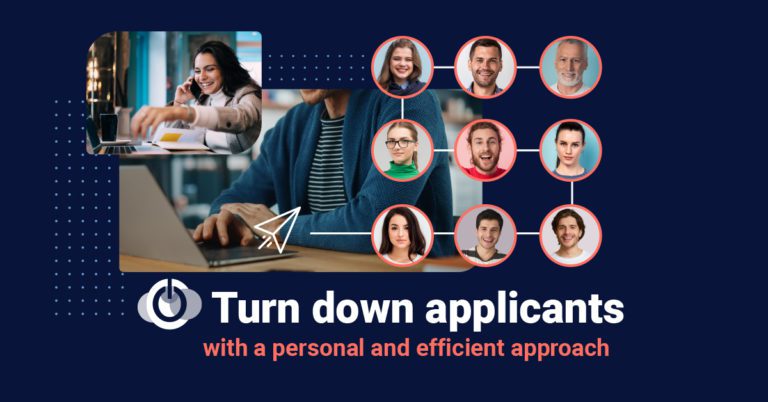How to Turn Down Applicants With a Personal and Efficient Approach
Turning down applicants who don’t make it to the next round is never easy. And turning down potential employees who came close to landing the job is not any less difficult. In this post we take a look at how you can avoid spending an unnecessary amount of time doing this while remaining respectful towards the candidates.
In every recruitment process there is naturally an elimination process too. Who sparks your interest enough to make it to the next round? Who has the biggest potential? Not everyone can be the right fit, which is why elimination is necessary, and while this step can be tough, it is often repeated a few times in the recruitment process.
One of the most important things to keep in mind when it comes to rejecting candidates, is to let them know sooner rather than later. After the initial screening of the resumes and cover letters, it is likely that you can already exclude some candidates. If they are not relevant to the position you are offering, let them know right away.
Now you can give your attention to the candidates that you see as a better fit. As you make your way through the potential candidates, make sure you let them know when they are no longer being considered. This way you avoid wasting their time in their pursuit of their dream job.
First Round of Rejections
After you have chosen the candidates that you find interesting, it is sufficient to turn down the remaining candidates through an e-mail.
No personal reasoning is necessary in this e-mail. Simply thanking them for applying and letting them know you have chosen other profiles that you find would be a better fit for the position, is enough.
Are you a HR-ON client and do you use HR-ON Recruit?
Turn down potential candidates simply and easily through the recruitment platform. You can even turn down multiple candidates at once and reuse the blueprint for the next recruitment process.
Contact Support to know more.
Candidate Made It to an Interview, but Didn’t Get the Job? Give Them a Personal Rejection
At this point in the recruitment process you have found the candidates that you would like to go through a test, maybe a case and eventually a job interview. This next step naturally calls for another round of rejections.
Calling up the candidates that took time out of their day to be at the job interview but didn’t quite make it is a huge merit for the reputation of your organization. When you deliver the rejection orally, it is easier to show empathy for your candidate when they hear the disappointing news.
Turning them down orally is a way of showing respect to the potential candidates, as simply receiving a letter of rejection via e-mail can be kind of a downer. Especially if the candidate actually left the interview with a good feeling and may even expect to receive good news. Written rejections can be difficult to ace as e-mails are easy to perceive as impersonal.
Substantiate the Rejection
Keep in mind that the candidates have spent time writing the application, completing a test or a case and participated in the interview. Considering all this, it is why it is a sign of respect to personally deliver the rejection. This will also benefit a potential future run-in with the candidate – physically as well as virtually on social media. It could be that the candidate would like to pursue another open position in the future – and that would only be relevant if the candidate felt like they were being treated with dignity and respect.
No long phone calls are necessary, but a simple call where your main focus is to let it be known from the beginning that the candidate is not being considered for the job. After you have delivered this message, you can ask the candidate whether they would like to know the reason for that.
Should the candidate agree to hear the reasoning behind your decision, you should initiate this by pointing to a few positive things that you noticed about the candidate during the interview. Later, you can dive into what aspects and qualities you would like the candidate to have had if they should have been offered the position. By doing it this way you offer the candidate useful feedback while advising them on what they can do better in future interviews.
Avoid Falling Foul of the Law
When rejecting candidates, on the phone as well as through e-mail, it is important that you remain professional. Make sure you focus solely on the professional skills and experiences that would be necessary for the position the candidate applied to.
Avoid mentioning criteria that would be illegal to base your rejection on. Keep in mind that discriminatory practice makes it illegal to turn down candidates based on gender, age, religion, handicap, political views, sexual orientation, and ethnicity. Violating this can result in a hefty fine – in addition to wrecking your reputation.
Send Out Personal Rejections Efficiently With HR-ON Recruit
If you are a HR-ON client, and have access to HR-ON Recruit, part of the rejection process can be done with just a few clicks. On the platform you can find several different email drafts that you can adapt to your requirements. This way you can save time and easily execute the rejection process once you have your appropriate email draft.
By using the email draft, you can send out rejections to multiple candidates at once. Personal info such as name and details of the sender is automatically merged into the email, so it appears personal once the candidate receives it.
HR-ON Recruit even allows you to change who the sender should be. For coherence reasons it should be one of the employees that has participated in the recruitment process, and this would also make the letter of rejection more personal. Using this application gives you time to focus on the more important task – the personal rejection calls for the candidates that almost made it.


